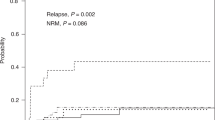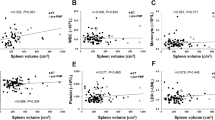Abstract
Although splenomegaly is major characteristic of primary myelofibrosis (PMF), splenomegaly has been devalued due to a less reliable method based on physical examination (PEx). We evaluated whether spleen volume (SV) on CT would accurately predict clinical outcomes in PMF. A total of 188 patients were enrolled. SV was quantitated by the automatic volume software. In ROC curve, the SV predicted prognosis more accurately than spleen length by PEx (p < 0.001). The ideal cut-off value was 378.1 cm3 for SV, which was divided into high- and low-volume status. Patients with low SV status had superior leukemia-free survival and overall survival compared to high SV status (p < 0.001, p < 0.001) In the Cox analysis, old age ≥65 years (p = 0.004, p = 0.001), low Hemoglobin <10.0 g/dL (p = 0.023, p = 0.021), high WBC counts ≥25 × 109/L (p = 0.003, p = 0.006), peripheral blasts ≥1 % (p = 0.029, p = 0.020), unfavorable cytogenetic abnormalities (p = 0.025, p = 0.028), and high SV status (p = 0.004, p = 0.003) were independently associated with survivals. SV measured by CT was important for predicting survival in patients with PMF.



Similar content being viewed by others
References
Vardiman JW, Thiele J, Arber DA, Brunning RD, Borowitz MJ, Porwit A, et al. The 2008 revision of the World Health Organization (WHO) classification of myeloid neoplasms and acute leukemia: rationale and important changes. Blood. 2009;114:937–51.
Cervantes F, Barosi G, Demory JL, Reilly J, Guarnone R, Dupriez B, Pereira A, et al. Myelofibrosis with myeloid metaplasia in young individuals: disease characteristics, prognostic factors and identification of risk groups. Br J Haematol. 1998;102:684–90.
Cervantes F, Pereira A, Esteve J, Rafel M, Cobo F, Rozman C, et al. Identification of ‘short-lived’ and ‘long-lived’ patients at presentation of idiopathic myelofibrosis. Br J Haematol. 1997;97:635–40.
Reilly JT, Snowden JA, Spearing RL, Fitzgerald PM, Jones N, Watmore A, et al. Cytogenetic abnormalities and their prognostic significance in idiopathic myelofibrosis: a study of 106 cases. Br J Haematol. 1997;98:96–102.
Kvasnicka HM, Thiele J, Werden C, Zankovich R, Diehl V, Fischer R. Prognostic factors in idiopathic (primary) osteomyelofibrosis. Cancer. 1997;80:708–19.
Dupriez B, Morel P, Demory JL, Lai JL, Simon M, Plantier I, et al. Prognostic factors in agnogenic myeloid metaplasia: a report on 195 cases with a new scoring system. Blood. 1996;88:1013–8.
Cervantes F, Dupriez B, Pereira A, Passamonti F, Reilly JT, Morra E, et al. New prognostic scoring system for primary myelofibrosis based on a study of the international working group for myelofibrosis research and treatment. Blood. 2009;113:2895–901.
Passamonti F, Cervantes F, Vannucchi AM, Morra E, Rumi E, Pereira A, et al. A dynamic prognostic model to predict survival in primary myelofibrosis: a study by the IWG-MRT (international working group for myeloproliferative neoplasms research and treatment). Blood. 2010;115:1703–8.
Gangat N, Caramazza D, Vaidya R, George G, Begna K, Schwager S, et al. DIPSS plus: a refined dynamic International Prognostic Scoring System for primary myelofibrosis that incorporates prognostic information from karyotype, platelet count, and transfusion status. J Clin Oncol. 2011;29:392–7.
Reilly JT. Idiopathic myelofibrosis: pathogenesis, natural history and management. Blood Rev. 1997;11:233–42.
Koch CA, Li CY, Mesa RA, Tefferi A. Nonhepatosplenic extramedullary hematopoiesis: associated diseases, pathology, clinical course, and treatment. Mayo Clin Proc. 2003;78:1223–33.
Verstovsek S, Kantarjian H, Mesa RA, Pardanani AD, Cortes-Franco J, Thomas DA, et al. Safety and efficacy of INCB018424, a JAK1 and JAK2 inhibitor, in myelofibrosis. N Engl J Med. 2010;363:1117–27.
Tefferi A, Thiele J, Orazi A, Kvasnicka HM, Barbui T, Hanson CA, et al. Proposals and rationale for revision of the World Health Organization diagnostic criteria for polycythemia vera, essential thrombocythemia, and primary myelofibrosis: recommendations from an ad hoc international expert panel. Blood. 2007;110:1092–7.
Thiele J, Kvasnicka HM, Facchetti F, Franco V, van der Walt J, Orazi A. European consensus on grading bone marrow fibrosis and assessment of cellularity. Haematologica. 2005;90:1128–32.
Hussein K, Pardanani AD, Van Dyke DL, Hanson CA, Tefferi A. International prognostic scoring system-independent cytogenetic risk categorization in primary myelofibrosis. Blood. 2010;115:496–9.
Caramazza D, Begna KH, Gangat N, Vaidya R, Siragusa S, Van Dyke DL, et al. Refined cytogenetic-risk categorization for overall and’leukemia-free survival in primary myelofibrosis: a single center study of 433 patients. Leukemia. 2011;25:82–8.
Mesa RA, Nagorney DS, Schwager S, Allred J, Tefferi A. Palliative goals, patient selection, and perioperative platelet management: outcomes and lessons from 3 decades of splenectomy for myelofibrosis with myeloid metaplasia at the Mayo Clinic. Cancer. 2006;107:361–70.
Mesa RA, Silverstein MN, Jacobsen SJ, Wollan PC, Tefferi A. Population-based incidence and survival figures in essential thrombocythemia and agnogenic myeloid metaplasia: an Olmsted County Study, 1976–1995. Am J Hematol. 1999;61:10–5.
Tefferi A, Huang J, Schwager S, Li CY, Wu W, Pardanani A, et al. Validation and comparison of contemporary prognostic models in primary myelofibrosis: analysis based on 334 patients from a single institution. Cancer. 2007;109:2083–8.
Barosi G, Berzuini C, Liberato LN, Costa A, Polino G, Ascari E. A prognostic classification of myelofibrosis with myeloid metaplasia. Br J Haematol. 1988;70:397–401.
Visani G, Finelli C, Castelli U, Petti MC, Ricci P, Vianelli N, et al. Myelofibrosis with myeloid metaplasia: clinical and haematological parameters predicting survival in a series of 133 patients. Br J Haematol. 1990;75:4–9.
Rupoli S, Da Lio L, Sisti S, Campanati G, Salvi A, Brianzoni MF, et al. Primary myelofibrosis: a detailed statistical analysis of the clinicopathological variables influencing survival. Ann Hematol. 1994;68:205–12.
Njoku OS, Lewis SM, Catovsky D, Gordon-Smith EC. Anaemia in myelofibrosis: its value in prognosis. Br J Haematol. 1983;54:79–89.
Miller JB, Testa JR, Lindgren V, Rowley JD. The pattern and clinical significance of karyotypic abnormalities in patients with idiopathic and postpolycythemic myelofibrosis. Cancer. 1985;55:582–91.
Demory JL, Dupriez B, Fenaux P, Laï JL, Beuscart R, Jouet JP, et al. Cytogenetic studies and their prognostic significance in agnogenic myeloid metaplasia: a report on 47 cases. Blood. 1988;72:855–9.
Tefferi A, Mesa RA, Nagorney DM, Schroeder G, Silverstein MN. Splenectomy in myelofibrosis with myeloid metaplasia: a single-institution experience with 223 patients. Blood. 2000;95:2226–33.
Tefferi A. Myelofibrosis with myeloid metaplasia. N Engl J Med. 2000;342:1255–65.
Panteli KE, Hatzimichael EC, Bouranta PK, Katsaraki A, Seferiadis K, Stebbing J, et al. Serum interleukin (IL)-1, IL-2, sIL-2Ra, IL-6 and thrombopoietin levels in patients with chronic myeloproliferative diseases. Br J Haematol. 2005;130:709–15.
Verstovsek S. Therapeutic potential of Janus-activated kinase-2 inhibitors for the management of myelofibrosis. Clin Cancer Res. 2010;16:1988–96.
Author information
Authors and Affiliations
Corresponding author
Ethics declarations
Conflict of interest
The authors have no conflict of interest.
About this article
Cite this article
Song, MK., Chung, JS., Lim, SN. et al. Usefulness of spleen volume measured by computed tomography for predicting clinical outcome in primary myelofibrosis. Int J Hematol 104, 476–484 (2016). https://doi.org/10.1007/s12185-016-2050-y
Received:
Revised:
Accepted:
Published:
Issue Date:
DOI: https://doi.org/10.1007/s12185-016-2050-y




